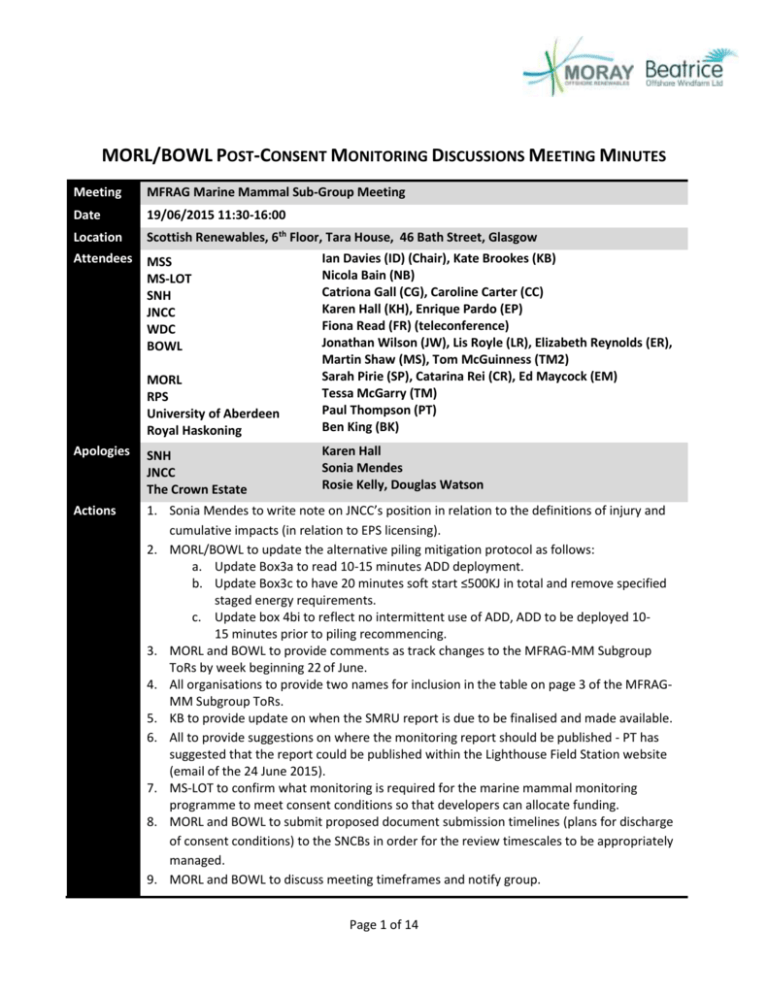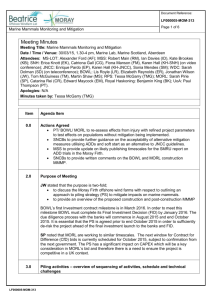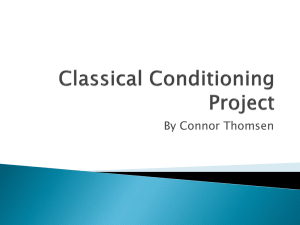Open
advertisement

MORL/BOWL POST-CONSENT MONITORING DISCUSSIONS MEETING MINUTES Meeting MFRAG Marine Mammal Sub-Group Meeting Date 19/06/2015 11:30-16:00 Location Scottish Renewables, 6th Floor, Tara House, 46 Bath Street, Glasgow Attendees MSS MS-LOT SNH JNCC WDC BOWL MORL RPS University of Aberdeen Royal Haskoning Ian Davies (ID) (Chair), Kate Brookes (KB) Nicola Bain (NB) Catriona Gall (CG), Caroline Carter (CC) Karen Hall (KH), Enrique Pardo (EP) Fiona Read (FR) (teleconference) Jonathan Wilson (JW), Lis Royle (LR), Elizabeth Reynolds (ER), Martin Shaw (MS), Tom McGuinness (TM2) Sarah Pirie (SP), Catarina Rei (CR), Ed Maycock (EM) Tessa McGarry (TM) Paul Thompson (PT) Ben King (BK) Apologies SNH JNCC The Crown Estate Karen Hall Sonia Mendes Rosie Kelly, Douglas Watson Actions 1. Sonia Mendes to write note on JNCC’s position in relation to the definitions of injury and cumulative impacts (in relation to EPS licensing). 2. MORL/BOWL to update the alternative piling mitigation protocol as follows: a. Update Box3a to read 10-15 minutes ADD deployment. b. Update Box3c to have 20 minutes soft start ≤500KJ in total and remove specified staged energy requirements. c. Update box 4bi to reflect no intermittent use of ADD, ADD to be deployed 1015 minutes prior to piling recommencing. 3. MORL and BOWL to provide comments as track changes to the MFRAG-MM Subgroup ToRs by week beginning 22 of June. 4. All organisations to provide two names for inclusion in the table on page 3 of the MFRAGMM Subgroup ToRs. 5. KB to provide update on when the SMRU report is due to be finalised and made available. 6. All to provide suggestions on where the monitoring report should be published - PT has suggested that the report could be published within the Lighthouse Field Station website (email of the 24 June 2015). 7. MS-LOT to confirm what monitoring is required for the marine mammal monitoring programme to meet consent conditions so that developers can allocate funding. 8. MORL and BOWL to submit proposed document submission timelines (plans for discharge of consent conditions) to the SNCBs in order for the review timescales to be appropriately managed. 9. MORL and BOWL to discuss meeting timeframes and notify group. Page 1 of 14 Please note: List of acronyms provided at the end of these minutes 1. Introductions ID opens the meeting and introductions are made. It is noted that the minutes from the previous MFRAG-Marine Mammals Subgroup (MFRAG-MM Subgroup) meeting have not been finalised yet. 2. Purpose of the meeting ID stated that the purpose of the meeting is to formalise the MFRAG-MM Subgroup and to progress discussions on the development of marine mammal monitoring and mitigation strategies. The documents made available for discussion during the meeting were: 1) Protocol for Mitigating Effects on Marine Mammals During Piling at BOWL and MORL (latest version submitted for review 01/06/2015); 2) A strategic regional Marine Mammal Monitoring Programme for assessing the population consequences of constructing the BOWL and MORL wind Farm Developments (latest version submitted 20/05/2015; 3) Strategic Regional Pre-Construction Marine Mammal Monitoring Programme Annual Report 2015 (dated 06/05/2015). Other items on the agenda were; Approach to development of Piling Strategy (Item 4 on the agenda); MFRAG Sub-group terms of reference (item 5 on the agenda); On-going marine mammal monitoring programme funding requirements (item 7 on the agenda); and EPS Licensing (item 8 on the agenda). 3. Discussion of “Protocol for Mitigating Effects on Marine Mammals During Piling at the BOWL and MORL Wind Farms” (submitted 1st June 2015) 3.1 Scope of mitigation document ID reminded group that at the last MFRAG meeting it was decided that subgroups could send final comments to MS-LOT on documents if a majority of the sub-group members agree. The aim of the current subgroup meeting would be to hopefully achieve sign-off of mitigation protocol if all agreed. JW explained that both developers were looking for support for the protocol as soon as possible so that the costs associated with the agreed strategy are known and the protocol can be included in PS which is to be Page 2 of 14 submitted very soon (by the end of July for BOWL). ID confirmed that the documents submitted were as anticipated. PT provided a brief introduction to the mitigation protocol and explained that it had been produced through consultation with engineers from both developers. PT requested feedback from group and asked if all parties were clear regarding the scope of the document. CG confirmed SNH were clear on the scope of the document and that SNH recognised that the document is aimed at addressing instantaneous death and injury and does not try to mitigate cumulative noise impacts or disturbance. KH also confirmed that JNCC agreed that this is the scope of the document but reminded the group that the EPS licence criteria requires cumulative impacts to be considered although recognised that cumulative impacts are difficult to mitigate. CG highlighted that current JNCC mitigation protocols do not address cumulative noise impacts and that Marine Scotland guidance does not specify the need for mitigation to address cumulative noise impacts within its EPS licencing guidance. ID reminded the group that at the last meeting it was decided that the protocol would only include instantaneous injury. KH suggested that a risk based approach could be used to address cumulative noise concerns. KH stated that JNCC would like to see more evidence on the effectiveness of ADDs to allow for a greater level of comfort over their use as a primary mitigation method for HS and HP. There was recognition that ORJIP 4 will not deliver quickly enough for MORL/BOWL timescales but the ORJIP 4 process still needs to be considered. JNCC also need to consider alterations to protocols from a UK-wide perspective. CC confirmed that SNH are supportive of the approach detailed in the protocol and that they are happy that the document addresses pre-piling risk, but further discussions about ‘trialling of ADDS’ are required. ID summarised that all parties in the room were in agreement that the protocol provides short range and short duration protection and does not cover cumulative impacts which are dealt within the EIA and requested comments from FR. FR noted that the document does not discuss monitoring of ADDs effectiveness or whether MMO and PAM would be used in parallel to ADDs. PT responded that the protocol is a stand-alone document for agreement of general principles and that the monitoring of ADD effectiveness will be discussed as part of the monitoring programme for discussion in the afternoon session. CG noted that there are several points within the JNCC protocol that allow developers flexibility in their approach (section about variation of the protocol). CG also highlighted that SNH are not a signatory to the JNCC protocol and that the protocol is not linked to the Scottish EPS licencing framework in Scottish Territorial Waters (SWT). CG questioned the precedent for the use of the JNCC protocol within STW highlighting that the Robin Rigg OWF was built prior to the JNCC Guidance being developed. KB noted that most mitigation protocols undertaken for piling within STW (mainly ports and harbour work) are based on the JNCC protocol. PT highlighted that when considering designing protocols for addressing cumulative impacts, there remains significant uncertainty over how to assess likelihood of PTS or its subsequent impacts. PT noted that discussions at the recent ORJIP meeting indicate that changes in guidance within the US may mean that PTS is no longer considered an ‘injury’ by US regulators. Page 3 of 14 FR noted agreement of the general principles of the mitigation protocol. FR suggested that the potential HP SAC may have an impact on monitoring requirements. ID stated that the HP SAC is not being discussed at this meeting as it does not exist yet nor are the conservation objectives defined and that it will be addressed as part of a separate work stream. After this FR’s connection was lost for the rest of the meeting due to technical difficulties. CG highlighted that the protocol does actually refer to HP and PT confirmed that all species are taken into account. Action Sonia Mendes to write note on JNCC’s position in relation to the definitions of injury and cumulative impacts (in relation to EPS licencing). 3.2 Discussion of Protocol PT and TM provided a summary of the proposed mitigation procedures as presented in the protocol and the general approach to piling. EM/TM2 highlighted that it is likely that there will be around six hours of background activity prior to any piling activities commencing and that as the MORL and the BOWL projects have different engineering/technical characteristics that the protocol represents the worst case scenario. KH questioned whether 5-6 blows at 10 second intervals is likely to be the maximum number of blows/blow rate. EM stated that once piling starts the blow rate will be a blow every couple of seconds but the initial blows are used to seat the pile. The blow intervals can be adjusted at this stage if required but would generally be about 6 blows, 10 seconds apart. Hammer energies used to inform the soft start energy in the mitigation protocol is based on a 2500 kJ hammer, which is the largest hammer that is anticipated to be used at the BOWL and MORL sites. The ADD will be deployed prior to piling with sufficient time to allow an animal to flee twice the injury zone (as determined by hammer energy at that site). EM confirmed that the ADD operator would, in MORL’s case, be procured by MORL and report directly to MORL as the client. KH asked how much information on hammer energies will be known prior to undertaking piling. MS/EM replied that there will be a good idea of the hammer energies required across the wind farm sites prior to piling, however, the precise hammer energies would not be known until the actual piling is carried out. KH noted that for the noise monitoring it would be useful to see the results from areas where higher energies are predicted. 3.2.1 Discussion of Figure 1 BOX 3a TM explained that ADD deployment is determined by the size of the injury zone at each pile (based on predicted hammer energies) and the animal’s swimming speed. Hammer energy for the calculation is based on initial maximum soft-start energy of 300 kJ. CC stated that there is evidence suggesting that marine mammals may not react as predicted to ADDs and suggested deploying ADDs for longer to provide contingency. SNH/JNCC agreed that ADD deployment for 1015 minutes prior to soft start would be preferable to avoid excessive noise but enough to provide Page 4 of 14 contingency. In discussion of ADD operation/switch off- CC noted that switch off of the ADD at start of piling would be preferred. CC/ID suggested that recording of noise emissions from ADD and piling (soft start) would be useful. BOX 3b All in agreement with content. Box 3c TM explained that the soft start has been split into two phases to equal a 20 minutes overall soft start procedure in line with the JNCC guidelines. The first phase of 5-10 minutes is at hammer energy of less than 300 KJ. The second phase is at an energy of less than 500 KJ for the remainder of the 20 minutes soft stat. A 20 minutes soft start would be primarily for mitigation purposes rather than as an engineering soft start. JNCC/SNH confirmed they were happy that a gradual ramp up of less than 500 KJ over 20 minutes is acceptable rather than specifying durations of different hammer energies within the soft start. BOX 3d All in agreement with content. No further comments were provided on Figure 1, all were in agreement that content is acceptable provided suggested changes are made. 3.2.2 Discussion of Figure 2 PT provided a summary of Figure 2. TM explained that the 2.5 hours break distinction is based on the DEPONS work which suggests this is the length of time before disturbed harbour porpoise return to an area. SNH and JNCC queried the need to redeploy the ADD during the 2.5 hours break (intermittent deployment). TM explained that redeployment would provide contingency to maintain the ‘hole in the population’ around the piling location until piling itself recommences. CC highlighted that habituation may be an issue during this ‘intermittent ADD deployment’ and PT agreed and explained that the rationale for not proposing a continuous deployment was to try to prevent this issue. ID enquired about the time required to move from one pile to the next (within the same foundation). EM explained that change over between piles could be around an hour and it was the intention to treat this as a break in piling rather than the start of a new piling event in respect to soft start, however an engineering soft start would still be required. BOX4a EM explained that the duration between piling events will decrease throughout the programme as the installation team become more experienced on the site but it will always be difficult to predict timing and duration of unplanned breaks. The 2.5 hour break would cover any type of break (planned or unplanned) and has been suggested purely on how long marine mammals are likely to absent for. ID requested agreement with the principle of a 2.5 hours break, noting that if break is shorter than 2.5 hours there would be a shorter soft start before piling recommences, if the break is longer than 2.5 hours the Page 5 of 14 protocol would return to that described in Figure 1. All agreed they were happy with the principle. Box 4bi KH/CC queried the intermittent use of ADDs during breaks less than 2.5 hours long. SNH/JNCC/MSS concluded that an intermittent deployment of ADDs is not particularly beneficial. ID suggested that the intermittent deployment of ADDs could be undertaken at random intervals, but the group agreed that the simplest solution would be to deploy ADDs for 10-15 minutes prior to recommencement of piling for breaks less than 2.5 hours instead. Where the break is less than 10 minutes the group was happy that piling could recommence with no ADD deployment or soft start (in line with JNCC protocol). KB/CC/ID suggested that if unplanned break occurs before the end of soft start, the soft start procedure would begin again following that described in Figure 1, starting with Box 3a. PT suggested that one useful objective of the ADD monitoring would be to quantify variation in these return times. This information could then be used to inform decisions over these timings for future developments. 3.3 Mitigation protocol sign-off ID led discussion on signing-off of the protocol. KH stated that JNCC have two concerns with the protocol 1) confirming that ADDs work effectively 2) the lack of MMOs and PAM to act as contingency if ADDs do not work. CC queried how ADDs will be tested/ their effectiveness monitored. PT explained that MMOs and PAM were not proposed in the protocol as an active part in mitigation as the predicted risk of marine mammals being within the impact zone was so low and there is no evidence that MMOs and PAM provides additional protection (especially for harbour seals which are the key receptor at the MF sites). Furthermore, this would conflict with the key objective of this protocol to provide predictable engineering timescales. However monitoring would be undertaken in an attempt to assess whether the ADD protocol is working. Monitoring strategies are discussed within the MMMP document to be discussed during afternoon session. PT confirmed that available data suggest that the use of ADDs presents a lower risk approach than using MMOs and PAM. JNCC confirmed they would like to see the noise modelling of a larger mitigation area to compare against use of a 500 m zone. PT explained that the ES assessed how many HP might be disturbed or affected by PTS through cumulative noise exposure, but not nearfield injuries. New modelling is being undertaken that will include injury. PT added that there is no point in including BND as it is a low risk species in the MORL/BOWL area and no impact is expected given there was no evidence of PTS from cumulative noise exposure in the ES. BOWL closed the morning session by saying that they are looking to submit the PS imminently and looking for sign-off on the alternative mitigation protocol ASAP to enable the PS to be completed. Actions Update Box3a to read 10-15 minutes ADD deployment. Page 6 of 14 Update Box3c to have 20 minutes soft start ≤500KJ in total and remove specified staged energy requirements. Update box 4bi to reflect no intermittent use of ADD, ADD to be deployed 10-15 minutes prior to piling recommencing. LUNCH 4. MFRAG Marine Mammal Subgroup Terms of Reference (ToRs) ID highlighted that the ToRs currently state that a formal endorsement from the MFRAG parent group of the subgroups advice to MS-LOT is required however this was discussed at the previous MFRAG meeting and it was agreed that the subgroup can perform sign-off on matters (Point 18 of the ToR). CR commented that timescales for the production and sharing of documents (meeting minutes etc) should be made consistent with parent group ToRs. KB suggested that a period to comment on meeting notes should be stated to avoid late approval of minutes. There is also the issue of the Secretariat being responsible for publishing minutes, which would be difficult to achieve. SP requested that protocol for escalation to MS-LOT should also be made consistent with parent group ToR. LR asked whether two representatives from each organisation is appropriate and questioned whether specialists can be brought into meetings if needed. KB suggested leaving the proposed ‘two representatives per organisation’ membership to prevent ‘over membership’ but suggested changing wording to allow additional specialists to be brought in if formally requested. Defined members would be able to vote on topics but guests would not. CR raised the issue of meeting frequency and that the subgroup should meet before the parent group to agree items and inform MFRAG rather than bringing items to MFRAG undiscussed. To work with timescales subgroup meetings would be needed at least one month before the main MFRAG meetings. It was noted that there are currently no linkages between other subgroups but the ToRs will be the same for all subgroups. Actions MORL and BOWL to provide comments as track changes to the MFRAG-MM Subgroup ToRs by week beginning 22 of June. All organisations to provide two names for inclusion in the table on page 3 of the MFRAG-MM Subgroup ToRs. 5. Discussion of “A strategic regional Marine Mammal Monitoring Programme for assessing the population consequences of constructing the BOWL and MORL wind Farm Developments” (revised report, 20th May 2015) 5.1 General Monitoring Scope Discussions continued on the mitigation protocol before the Group moved on to discuss the monitoring proposal. Page 7 of 14 KH highlighted that the new mitigation protocol is a practical shift away from the current JNCC protocol and that they would like to see an interim step to determine ADDs effectiveness and that this should be approached through the use of MMO and PAM as contingency. If this is not accepted, a risk based approach could be taken to justify a low risk to marine mammals through use of protocol. CG suggested a test period for protocol could be implemented during the early stages of piling. KH reiterated that JNCC’s preferred approach would be the use of MMOs and PAM as part of the mitigation as an interim step, but she noted that the majority of the group did not support this position.CG suggested that testing should be based on the available evidence and it should be assumed that the protocol will work and that the monitoring is about confirming that it works. KH confirmed that JNCC would require further information before it is confident that the protocol will work. PT pointed out that no survey will provide 100% confidence that an ADD or MMO based protocol would work. Even designing a robust experiment to provide >95% confidence in the effectiveness of an ADD will be challenging. ID led discussion of what ‘can be proved’. HP density is too low to study effectively and would require a risk assessment based approach. The SMRU work shows adverse reactions from seals to ADDs at up to 1 km from the noise source. KB highlighted that the SMRU report is currently being finalised and that it is to be published soon. ID pointed out that there are two years before construction of the (BOWL) wind farm commences and that during that period experimental work could be undertaken outside of ORJIP 4 format. PT suggested that the risk based approach is likely to be the only option going forward for MORL and BOWL. SP highlighted that a lot of the methods being discussed will feed into the ORJIP process and that that MORL are continuing to contribute to strategic studies as a way to bring the industry forward. PT explained that it is difficult to design a detailed monitoring programme at this stage as it would need to be designed around engineering programmes and a mitigation protocol that are not yet finalised. The main species for monitoring is HS, although there may now be a requirement to include HP due to the potential designation of a SAC. PT stated that the focus of monitoring needs to be to inform future developments, and it cannot be expected that results could feed back into any adaptive management of these developments. The design requires clarity over scope (whether one, both or no developments go ahead). SNH confirmed that they are content that the comments provided on the previous version of the construction monitoring proposal have been incorporated into the document. 5.2 General Monitoring Scope - WP3.1 and WP3.2 WP3.1 PT stated that there needs to be a clear definition between what is required to meet consent conditions and what is research that would not be required for the purpose of signing-off the discharge of conditions. Due to low numbers of BND on the MORL/BOWL sites, any research on ADDs in relation to BND would need to be undertaken elsewhere. ID suggested the possible use of playback experiments on the MORL/BOWL sites to determine responses to ADDs by HS to give some confidence of; 1) whether seals use the site as much as previously thought and; 2) if seals respond to ADDs as expected. If field studies are required, these would be strategic and should not be the responsibility of MORL/BOWL. Page 8 of 14 WP3.2 PT highlighted that the DEPONS study which explored the HP reactions to airgun play back though tagging could not be replicated in the Moray Firth. However, the Moray Firth does present a good opportunity to expand PAM monitoring to answer key questions such as the extent to which animals are displaced and return times. PT confirmed that there are no further CPOD surveys planned within the Moray Firth at this time. 5.3 Monitoring Responsibilities JW suggested that WP 3.1 and 3.2 should be assigned as developer’s responsibility and other WPs discussed further to determine the boundaries between monitoring and strategic research. ID suggested that in order to progress with ADD mitigation that the analysis of monitoring data could be undertaken early in the construction programme with the aim of showing that ADDs are effective. If not effective, research into the causes and the potential to use MMO and PAM as contingency could be discussed at this point. There needs to be a reasonable period of study to determine ADD effectiveness. If after 6 months results show that ADDs are not effective then there would be a need to adapt the protocol. Post-meeting note: Following exploration of monitoring options, PT agreed that monitoring has potential to show that ADD use is effective, because ADDs are likely to displace animals at much broader spatial scales than is required for mitigating instantaneous injury. However, this monitoring is unlikely to be able to show that ADD use was not effective at the finer (< 100m) scale required for mitigation. This is due both to low numbers of individuals within these smaller areas, and available techniques for fine-scale studies of marine mammal movement in offshore areas. This is the dilemma that prevents the use of this monitoring to inform adaptive use of different mitigation protocols during these developments. Monitoring can give us confidence that the ADD approach is working. It cannot tell us that it is not working with any confidence. Thus there will not be a robust evidence base to support a decision that one should stop using ADD and go back to the existing protocols using MMO & PAM. It was noted that BOWL’s piling strategy is to pile for approximately 6 months for the first year. KH stated that if no mitigation method is deemed appropriate then a risk based approach can be undertaken. EPS Licensing based on animal fatalities is not unprecedented and a risk assessment can prove piling is a licensable activity as there would be no overall impact on population. CG added that NRW have recently issued a licence based on fatality. ID noted that there has already been risk assessments undertaken both in the presence and absence of mitigation (within the ES and as detailed in the current piling protocol). There was an agreement from the group that there was a satisfactory outcome of the assessment of impacts with no mitigation, and that the use of any mitigation would simply reduce the risk. KH noted that risk assessment has been done for seals but would need to include other species too. KH added that one of the tests for EPS licensing is about ‘satisfactory alternatives’ and enquired if this test could be passed. NB replied that passing this test would not be a problem. Page 9 of 14 PT highlighted that one of the main issues with ORJIP are the timescales and that developers are wary of undertaking work within their development areas. In its current form ORJIP does not meet needs of the industry and may need to be modified in order to progress. PT suggested that smaller experiments could potentially be undertaken at development sites as opportunities arise (e.g. piling). KB noted that research projects may not work logistically alongside commercial developments and that developers may run risks of delays if experiments are undertaken during construction. SP confirmed that MORL are willing to investigate this approach but is not in a position to make firm commitments without a CfD and also a detailed understanding how such a project can work within the MORL construction zone. PT noted that ORJIP needs to understand the capabilities and limitations of research, designing experiments and undertaking surveys at sea. There also needs to be a mechanism for funding and it may be necessary to bypass ORJIP in order to get required work progressed. Possibly SpORRAn could be an outlet. Action KB to provide update on when the SMRU report is due to be finalised and made available. 6. A discussion of “Strategic Regional Pre-Construction Marine Mammal Monitoring Programme Annual Report 2015 (06/05/2015)”. 6.1 Discussion of results PT provided a summary of the recently finalised annual report covering the full first year of pre-construction monitoring. It was highlighted that the results show that seals use and forage within the wind farm areas less than previously anticipated. ID asked if the report will be made publically available. SP and JW confirm that MORL and BOWL are happy that is made available. Options were discussed about where it should be published. 6.2 Funding JW opened the discussion on the next phase of funding. PT explained that current funding covers monitoring until April 2016 after which there is no confirmed funding except the funding already committed by SNH for SAC Site Condition Monitoring. The Crown Estate have confirmed that they will no longer be providing funding. The funding for the third year of monitoring will be 10% less than the previous years as the scope will be reduced (no seal tagging) and it takes into account SNH contribution. 25% of funding would be required to cover each developer’s share, and if Marine Scotland can provide funding this should cover the whole amount required. There is a risk that if funding is not confirmed the current monitoring team could be lost. Confirmation of funding would be required by Q4 2015 to avoid this. JW suggested that more information about funding may be available by next meeting (August) but that there is a need to understand exactly what are the developer requirements (under MFRAG) and what is strategic and should not be responsibility of developers. Page 10 of 14 Actions All to provide suggestions on where the monitoring report should be published – PT has suggested that the report could be published within the Lighthouse Field Station website (email of the 24 June 2015). MS-LOT to confirm what monitoring is required for the marine mammal monitoring programme to meet consent conditions so that developers can allocate funding. 7. Any Other Business 7.1 Content of Piling strategy JW highlighted that BOWL intends to submit the PS at the end of July to get approval prior to FID. The EPS Licence application is to be submitted in August and therefore there would be a tight timescale for sign-off. SP confirmed that MORL anticipated submitting their PS in September with a view to approval before the next CfD allocation round which could take place in December. NB confirmed that the PS is for validity of noise related assessments rather than discussing effectiveness of ADDs which would be covered within the PEMP. BOWL suggested that there needs to be very clear instructions to manage expectations of consultees, in particular, that the PS is submitted to discharge consent conditions and not as a report to provide detailed information on other topics. Noise monitoring protocols would also be more appropriate contained within the PEMP. BOWL and MORL will not be submitting the PSs or PEMPs at the same time which will help managing stakeholder document review timeframes. 7.2 EPS Licensing BOWL indicated that the information within the PS will be used to inform the EPS licence application. BOWL would like to consult with stakeholders on the content of the application prior to submitting EPS application as there is little time for revisions to the document. CG confirmed that EPS licences in STW are valid for more than one year. NB confirmed that EPS license applications would be processed by MS-LOT if submitted now, even if construction is not due to commence until at least another 2 years or so. SNH and JNCC also confirmed that ambient noise monitoring is not required as there is sufficient information from other studies. Action MORL and BOWL to submit proposed document submission timelines (plans for discharge of consent conditions) to the SNCBs in order for the review timescales to be appropriately managed. 8. Next Meeting Developers agreed that August would be the preferred date for the next MFRAG-MM Subgroup meeting. Action MORL and BOWL to discuss meeting timeframes and notify group. Page 11 of 14 Page 12 of 14 List of Acronyms: ADD Acoustic Deterrent Device BND Bottlenose Dolphin BOWL Beatrice Offshore Windfarm Limited DEPONS Disturbance Effects on the Harbour Porpoise Population in the North Sea EIA Environmental Impact Assessment EPS European Protected Species FID Financial Investment Decision HP Harbour Porpoise HS Harbour Seal JNCC Joint Nature Conservation Committee MMMP Marine Mammal Monitoring Programme MMO Marine Mammal Observer MFRAG Moray Firth Regional Advisory Group MFRAG – MM Subgroup Moray Firth Regional Advisory Group – Marine Mammals Subgroup MORL Moray Offshore Renewables Limited MSS Marine Scotland Science MS-LOT Marine Scotland Licensing Operations Team NRW Natural Resources Wales OWF Offshore Wind Farm PAM Passive Acoustic Monitoring PEMP Project Environmental Monitoring Programme Page 13 of 14 PS Piling Strategy PTS Permanent Threshold Shift SAC Special Area of Conservation SNCB Statutory Nature Conservation Bodies SNH Scottish Natural Heritage SpORRAn Scottish Offshore Framework SMRU Sea Mammal Research Unit STW Scottish Territorial Waters ToR Terms of Reference WDC Whale and Dolphin Conservation Page 14 of 14 Renewables Research








